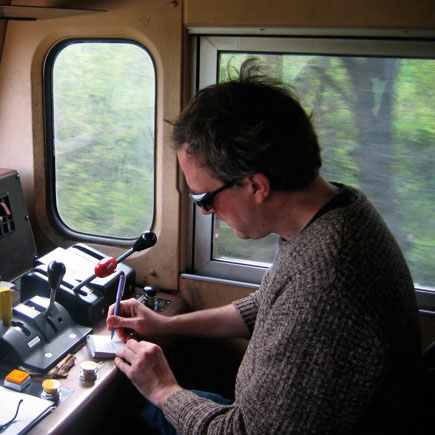newspoem 23 June 2008
Steel Wheels, Green Fields:
A Day on an Illinois Freight Train
William Gillespie
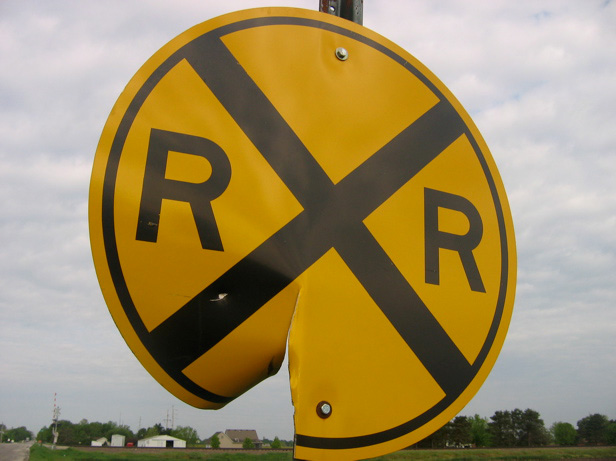
We hear them moaning in the dead of night, curse if they cross our paths when we are driving or make a wish if they pass over us.
Freight trains are a part of our landscape.
But who drives them? What do they carry? Why are there so many songs about them?
I had an opportunity to take a trip on one of those monsters and talk to the engineer about life on the rails. This reporting took place under the radar of the train company, so I have blurred certain facts, places, and names. Other than that, everything reported here is truth, exaggeration or hearsay.

Stepping out of the car by the railroad crossing on County Road 1 south of Silo, Illinois, I find myself alone, surrounded by hectares of horizon. Awkwardly, I stand by the side of the two-lane country road and pretend to be a corn photographer as the occasional truck driver passes and looks me over.
After half an hour of this, I wonder whether I will have to explain my presence to the county sheriff. “Not from around here, are you?” But when somebody comes for me, it is not the rural constabulary in a police cruiser, but my friend Casey the engineer piloting one and half miles of freight train. As the train inches to a stop at the crossing, I climb the steep metal steps on the tip of the engine, wrestle open the thick iron door and hit my head on the train's 17,000-ton mass as I enter and ascend the steps to the tiny cabin.
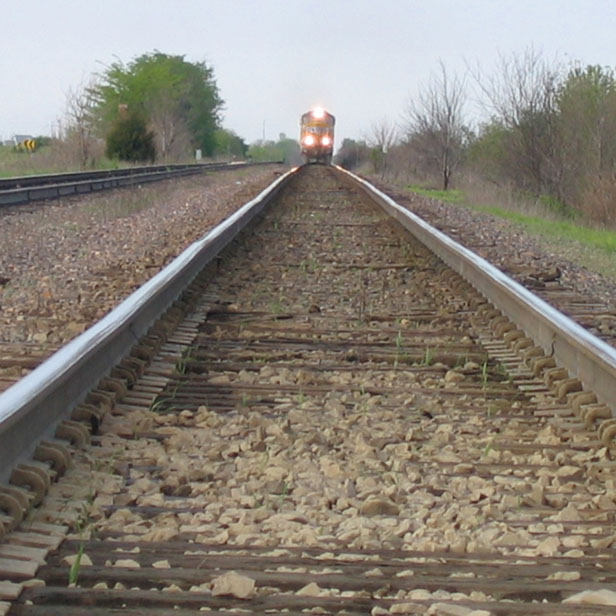
The space inside the engine where the engineer sits is roughly as big as the cockpit of a passenger jet, but with fewer instruments than a Toyota. A bank of grimy windows, augmented by binoculars at hand, allow the crew to see signals and any major problems there might be time to brake to avoid..
The train accelerates to 30 miles per hour. We float fifteen feet above a grade that tries to remain level as the land rises and falls. Like a ship plowing through a turbulent sea, sometimes we ride a ridge above the fields, other times we cut a trench beneath them. Our route slices through a cross section of Illinois few see. Not that there is much to see out here, far from major towns and highways.
From childhood picture-books I thought the conductor would be riding in the caboose with a lantern, but the engineer and conductor sit side by side. While the task of driving the train falls to the engineer, the conductor serves as co-pilot and is called to action if something goes wrong with the train. He does indeed have a lantern, and a huge duffel bag ("grip") of technical manuals, rules and regulations.
When I ask the conductor if he was lured to the position by the romantic mythology of the American railroad, he says no, he was just looking for work. The engineer is slightly more enamored of the job. He likes the independence, train music, scenery and the wildlife he gets to see: coyote, wild pheasant, wild turkey, deer. He speaks wistfully of routes along the Mississippi or in Oregon that offer more breathtaking vistas, and has in the past tried to get transferred to such areas, but is currently resigned to downstate Illinois.
The hours are irregular. They might be called in at 3 p.m. or 3 a.m., and might ride for six or sixteen hours. Typically they ride up north to Chicago, are put up in a hotel, and then drive another train down the next day.
Though the job of driving a train isn't “rocket science,” as the engineer tells me — he doesn't have to steer, obviously — there's a lot at stake. Those responsible for wrecks do not get a second chance; they are lucky to be unemployed instead of dead. The company doesn't even bother putting seatbelts in the cabin.
Braking a train is, as you can imagine, difficult. Casey said that to pick me up he had to begin preparing the braking maneuver a mile before he reached the crossing. Casey’s biggest worry as an engineer? “Stopping,” he says.

When I asked him the awful, inevitable question —whether he'd ever hit a vehicle — he says “not yet.” The possibility of hitting a car or truck is especially bad in Illinois, with its rural crossings without gates, tall corn restricting visibility and bad fog.
They do run over dogs, cats, deer and cows. Casey knows engineers who were involved in more serious accidents. We pass a crossing where a couple of crosses in the ditch commemorate an 18-year-old motorist who, after waiting for a train to pass, did not look the other way to see a second train coming before pulling across the tracks. His car was knocked into the ditch and caught fire. The engineer stopped the train and ran out with a fire extinguisher but it was too late.
Not so long ago a train was involved in a very serious collision with another train on an “interlocker” — where two perpendicular tracks cross. One of the crew of three was in the bathroom, another was sleeping and the rookie engineer overlooked a crucial signal and ran his train into the side of another passing train. Through some freak miracle, they sliced through the other train and derailed on the other side. There were injuries, but the crew were blessed and against all odds survived to stand on crutches in the unemployment line. In another incident, a trailer had fallen off another train unnoticed onto a railroad bridge. A train going the other way hit it, derailed and fell into the Kankakee River. That time, not everybody survived.
The locomotive I am riding is modern, built within the past five years. This train is actually being pulled by three engines which together have more than 13,000 horsepower. They can carry more than 5000 gallons of diesel. Older engines from the 1970s offer a more authentic experience. A deafening horn sits right over the cabin. The roof leaks. In the winter, the cabins are freezing and snow blows right in. And the older toilets are deplorable. Even in this modern engine, I would still rate the bathroom as a notch below a passenger jet and just above a porta-potty at the Chicago Blues Fest. Even the crew — jaded men — have not adjusted to the Medieval quality of the facilities and avoid using them.
Different sections of track have different speed limits. The maximum speed allowed for a freight train on this route is 60 MPH. Passenger trains such as Amtrak have a 70 MPH maximum. Back in the day, trains would periodically stop to have inspectors walk their length to look for problems. Now automatic sensors count the axles as they pass and a synthesized voice chirps the report over the radio.
The human crew has thus been pared down from several to two. They might someday be eliminated altogether.
We go up a hill, an Illinois hill — imperceptible save for the audible strain of the engines. With a mile and a half of train, even a small hill is something for the engineer to think about. He'll have part of the train going uphill while part is going downhill, and must control the tension by adjusting the brakes. The train, he says, is like a big slinky, and he must keep it either bunched up or extended. A sudden change of state can easily break it in two. A yellow signal crests the top of the rise.
We are hauling coal from southern Missouri to northern Illinois. It's an easy day at work for these two — a six-hour shift, midday. They will hand off the train with plenty of time to get a beer after work. Coal is not a very exciting cargo, but certainly preferable to toxic or nuclear material. Trains can carry anything, the engineer says, including any “bad stuff” or toxic materials that exist. Rules stipulate there must be five cars between the crew and any hazardous material, but they tell the story of the conductor who walked back to inspect the train and was instantly killed by leaking chlorine gas. Since September 11th, dispatchers (who track the movements of all trains and control the switches that adjust crossovers between tracks) are not housed in shacks along the tracks to pull levers when the train approaches, as I had pictured, but work in high-tech underground bunkers where illuminated maps show all the freight trains in the country moving coal, explosives or diapers. These hubs are located in central locations so protected and secure that I won’t mention which cities. Dispatchers are as important as air traffic controllers, because a train with a hazardous cargo is a potential threat to a city. A 70 mile-per-hour Amtrak filled with commuters colliding with a tanker full of toxins in an urban center would be a disaster in anybody's book, whether it were an accident or planned sabotage.
When they carry assorted cargo, it could be anything: food, guitars, UPS deliveries. Around the holidays, some trains carry only beer. (A mile and a half of train can carry a lot of beer.) With the rising cost of fuel, train transportation is becoming an increasingly attractive shipping option. Hundreds of semis worth of cargo can fit on a single train, after all, and that is often exactly what you see: trailers of the sort used on semi trucks stacked on “intermodal” flatbed cars.

There are neighborhoods near Chicago — most notoriously, Roseland — where things can get dicey. Citizens there throw rocks, shoot at the engineers or leave shopping carts on the tracks. Once some joker left a toilet on the tracks, but the engineer plowed on through and pulverized it to porcelain dust. If the train is forced to stop in these areas, the crew may not leave the cabin without an armed special agent escort. It is not uncommon in Roseland for thieves to climb onto a moving train, peel back the roofs of the trailers as if opening cans of sardines and toss down the cargo. This will by no means bring them good loot — they might get widescreen TVs, or… Depends (adult undergarments). They don't know until they open the boxes. Apparently one such criminal tossed out a bunch of boxes only to discover he had intercepted a shipment of bedpans. Reportedly tracks in the area are still littered with hundreds of bedpans.
But the route we are traveling is far from the inner city. Telephone poles sag under the weight of birds. Outside the emerald margins of the tracks, combed fields crisscross with the first green growth of spring. Rivers are at the bottom, towns are at the top, the engineer explains — the geographic wisdom of one who must remain astutely conscious of a subtle topography most of us can't see. We cross a river they don't know the name of. The locomotive normally sways from side to side just enough to make one wonder, so crossing even a stream is a bit nerve-wracking. If the train fell, you'd be exiting it from the river bottom if you were lucky enough to stay conscious. the engineer has crossed the Mississippi on a freight train and assures me that that is a high bridge. I imagine I would be alert if I were in charge of a train crossing the Mississippi. That's a deep river to be dragged to the bottom of by 17,000 tons of iron and coal.
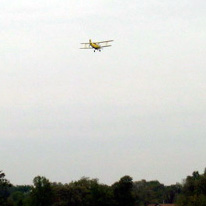 We pass what looks like a lost caboose sitting alone and picturesque on a spur track in the midst of a spray of weeds.
We pass what looks like a lost caboose sitting alone and picturesque on a spur track in the midst of a spray of weeds.
I am permitted to blow the horn as we approach one of many towns that seem to be towns in name only. I measure out the blasts: Long-long-short-long. We blow through Royton: three houses and a silo where the crew — when they stop — can receive ice cream sandwiches. Once past this stunted metropolis, we again see nobody all the way to the horizon except for a few lonely trucks who cautiously cross our paths on country roads and the occasional smiling, waving asparagus picker. North of Jethro we get buzzed by a yellow biplane that may be a crop duster. It swoops over the tracks and lands behind some nearby trees.
This route is mostly a single track but there are a few sidings that allow for “meetings” — when one train passes another. When we pass a train going the other way, the conductor throws an earnest wave through the little windows and, after passing, radios the word “highball” to let the other guy know that his train looks okay.
Railroaders all end up with nicknames. They tell stories. And, by the way, some of these fellas may take a drink now and again or be known to make a joke or two some might consider crude. It's a man's world. I am told that in the 1960s and 70s, in the spirit of the times, crews would engage in a lot of partying and tomfoolery on moving freight trains — real-life Casey Jones behavior — but a few critical accidents put a stop to that by the 80s. It's always fun until a school bus gets crushed.
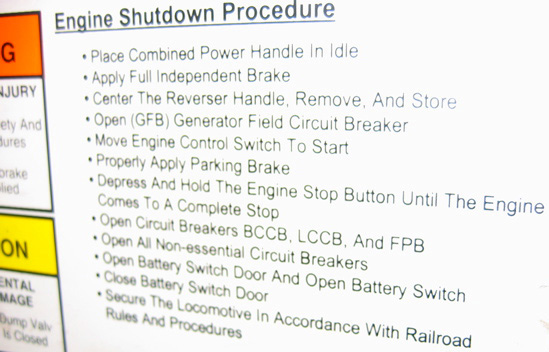
One time an engineer was coming through Wilma and looked back to notice that his second engine was on fire. He woke up his conductor and asked him: “ever seen that before?” The conductor said he hadn't and reckoned they ought to stop the train. With a couple-three thousand gallons of fuel on board, the engineer thought that might be a good idea, but maybe they should get through town first. So they passed through the city, dialed 911, got away from the train, and awaited the arrival of local volunteer fire departments from nearby townships. About four trucks and twenty firefighters of all ages and sizes showed up. There was quite a commotion. One grizzled old volunteer fireman, with no protective equipment save boots, went up to the burning engine and, as the younger guys yelled at him to stop, knocked open the door. Luckily the well-ventilated engine produced no fireball. The firefighters sprayed the engine down with foam and got the fire put out and, when they were getting ready to pack up, the engine burst back into flame. Finally they got the blaze under control. So the engineer radios his boss to see about getting the burnt engine hauled away but was told that they'd wasted enough time already, and that if the wheels still turned he should just drag the burnt-out hulk of it to the end of the line along with the rest of the cargo. So he did. That must have been a sight.
We approach my drop-off point near Mudflats. Near a mound of rusted farm equipment and tractor tires, I see a farmer in blue overalls dismounting a red tractor, surrounded by a cloud of doves. The sun shines over all this.
Highball.
